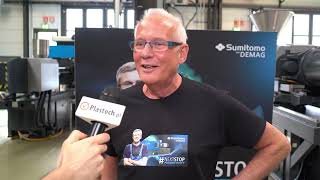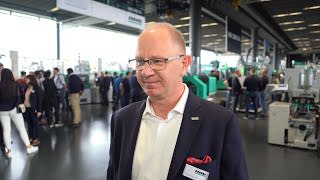 The cycle time reduction is without a doubt one of the most targeted productivity goals since the invention of the injection moulding machine.
The cycle time reduction is without a doubt one of the most targeted productivity goals since the invention of the injection moulding machine. The reason for this is simple: which processor wouldn’t like to utilise its investment-intensive production goods as efficiently as possible? The efforts for reducing cycle times are especially prominent on production systems used for mass production, for example in the packaging sector.
These packaging products also include the PET bottle, which is produced from the pre-product, i.e. the preform. Few manufacturers have succeeded in successfully realising production machines for manufacturing these preforms up until now.
Initially, shorter cycle times were mainly achieved for preform production with faster machine movements. These include rapid robot movements for preform removal and impressive speeds during the clamping process, which by the way are possible despite extremely high mould weights thanks to toggle lever technology. When combined, these two achievements result in lock-to-lock times which specifically strive for the two-second mark.
However, from an economical standpoint, the physical limits have already been reached. In addition, it was also possible to reduce the cycle time by shortening the injection time and optimising mould cooling using improved hot runner technology. Parallel to this development, it was naturally also necessary to focus on an increase in the plasticising performance with maximum, homogeneous melt quality.
It is entirely possible for an optimum, intensive cooling of the injection moulded part to result in the generation of additional reductions in the cycle time. However, there are also certain limits here depending on the wall thickness of the preform. For example, with produced wall thicknesses from approximately 2.5 mm, the duration of sufficient cooling is extremely important. For even if the outer skin of the plastic solidifies through proper cooling so that the preform can be demoulded without danger, from this wall thickness the remaining thermal energy is high enough to present a danger of re heating. In the case of a short cooling time, in jection moulded parts can therefore result, which soften again after a short time at the points with greater wall thicknesses, and as a result also have a higher thermal energy.
As already indicated, a preform demoulded after an extremely short cooling time still has a high share of thermal energy. This is particularly the case in areas with greater wall thicknesses – generally in the shaft area. If the intensive cooling of the outer skin is now interrupted, there is a risk of these sections softening again due to the residual heat.
The preform is guided into a cooling sleeve following mould removal for post-cooling, and therefore cools around the entire circumference. However, as the preform shrinks away from the walls of the cooling sleeve and is no longer supported by the mould core, it loses cooling contact to the cooling sleeve around its entire circumference with the exception of the contact surface.
Due to this one-sided separation of the preform from the cooling walls, cooling is interrupted around the circumference. This makes it impossible to obtain a radially uniform thermal image. And although the moulded part is in the first cooling sleeve for less than one cycle, it is marked with a heat profile within this short time which cannot be compen sated.


